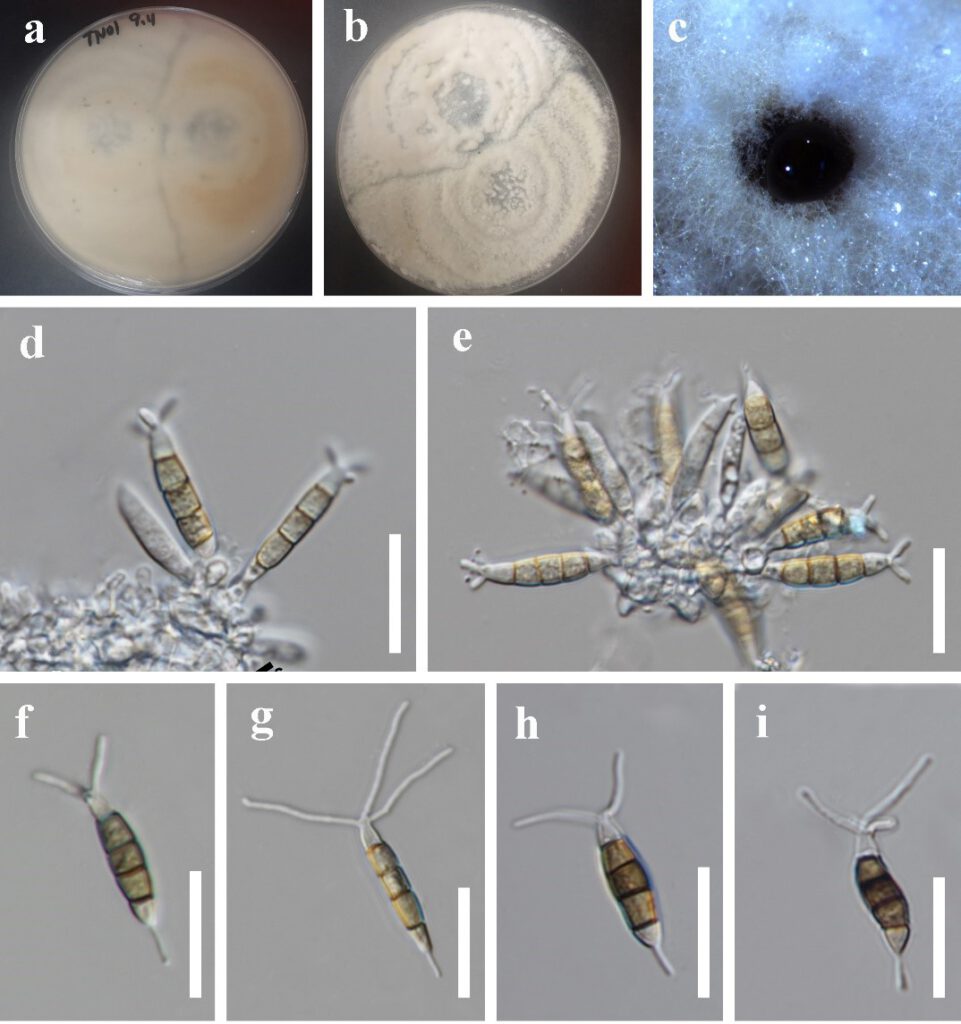Neopestalotiopsis suphanburiensis Y.R. Sun & Yong Wang bis, in Sun, Jayawardena, Sun & Wang, Microbiology Spectrum: e03987-22, 8 (2023)
Index Fungorum number: IF 571272; MycoBank number: MB 571272; Facesoffungi number: FoF 12916;
Etymology – refers to the province where the fungus was collected, Suphan Buri Province.
Holotype – MFLU 22-0168.
Saprobic on stems of an unidentified plant. Sexual morph: not observed. Asexual morph: Conidiomata solitary, subglobose to globose, unilocular, brown to dark, immersed on stems. Conidiophores indistinct, often reduced to conidiogenous cells. Conidiogenous cells subcylindrical, ampulliform, hyaline. Conidia 19 to 29 × 4 to 7 μm (x̄ = 25 × 5 μm, n = 40), L/W ratio = 4.9, fusiform, straight to slightly curved, 4 septate; basal cell obconic with a truncate base, hyaline, smooth walled, 3 to 7 μm long; three median cells 12 to 19 μm long (x̄ = 16 μm, n = 40), pale brown to brown, wall rugose, concolor, septa darker than the rest of the cell, versicolorous; second cell from base pale brown to brown, 3 to 7 μm long; third cell pale brown to brown, 3 to 6 μm long; fourth cell pale brown to brown, 4 to 6 μm long; apical cell 3 to 6 μm long, hyaline, conic to acute; with 2 to 3 tubular appendages on the apical cell, inserted at different loci in a crest at the apex of the apical cell, unbranched, 9 to 21 μm long; single basal appendage, unbranched, tubular, centric, 2 to 11 μm long.
Culture characteristics – Colony diameter reached 8 cm after 2 weeks at 25°C on PDA medium. Colonies were circular with a rough, flat surface and appeared white from above and white to pale gray from below.
Material examined – Thailand, Suphan Buri Province, dead stem of an unidentified plant, 5 September 2020, S Wang, TN01 (MFLU 22-0168, holotype); ex-type culture, MFLUCC 22-0126.
Notes – Neopestalotiopsis suphanburiensis is phylogenetically sister to N. eucalyptorum which was isolated from leaves and stems of Eucalyptus globulus (Fig. 1). In morphology, N. suphanburiensis differs from N. eucalyptorum in having thinner conidia (3.7–6.8 μm vs. 7.6–8.1 μm). In addition, there are 10 base pair differences (without gap, 445 bp) in the TEF region. The PHI test on N. suphanburiensis also indicated there is no significant recombination (Фw = 1.0) between N. suphanburiensis and its closely related taxa (Fig 2d). We thus introduce N. suphanburiensis as a new species.

Figure 8 – Neopestalotiopsis suphanburiensis (MFLU 22-0168, holotype). a, b Cultures. c Colony on culture. d, e Conidia attached to conidiogenous cells, f–i Conidia. Scale bars: d–i = 10 µm.
